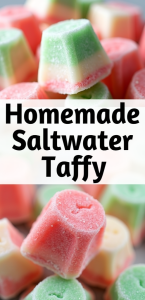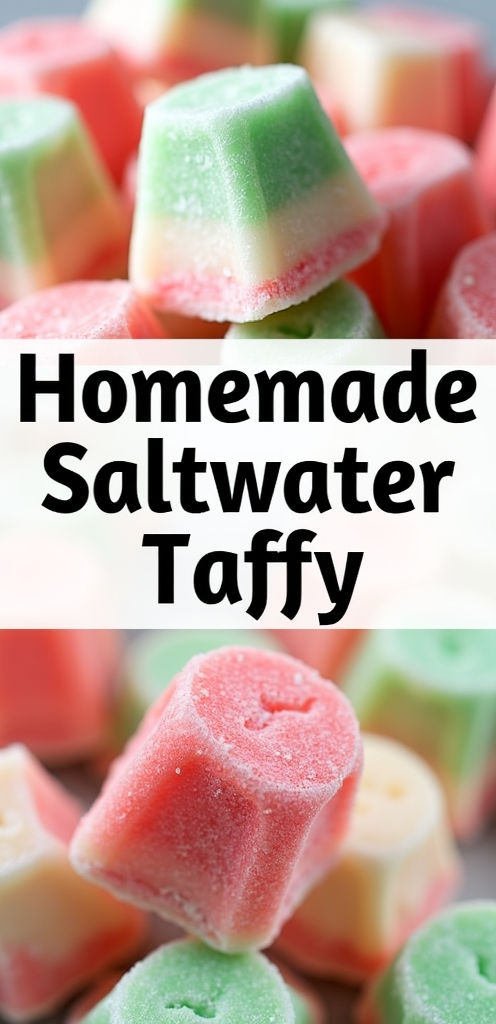Homemade Saltwater Taffy
Imagine standing on a bustling boardwalk, the scent of sweet saltwater taffy wafting through the air, a nostalgic reminder of carefree summer days. Making this confection at home can evoke similar feelings, blending creativity with a touch of precision. You might think it’s just about mixing sugar and syrup, but the process is more nuanced than that. As you explore the history and techniques behind this chewy delight, you’ll discover some surprising secrets that could elevate your homemade treats from ordinary to extraordinary.
Why You’ll Love This Recipe
When you try this homemade saltwater taffy recipe, you’ll discover it’s not just delicious—it’s a fun and engaging experience for everyone involved.
The quick preparation time of about 10 minutes makes it easy to start, and you won’t need any special machines—just a saucepan and basic kitchen tools. Understanding the importance of temperature control in candy making will help ensure your taffy turns out perfectly.
You’ll love how you can choose colorful options and various flavors, letting each person add their creative touch. This activity is perfect for gatherings, as a batch can serve 4-8 guests in the pulling process.
Remember, using a candy thermometer is essential to reach the right temperature.
With a few practical tips, you’ll create chewy, sweet taffy that rivals store-bought versions, making it a memorable treat for all!
History
Although many enjoy saltwater taffy today, its origins trace back to Atlantic City, New Jersey, in the early 1880s.
The story begins with John Ross Edmiston and David Bradley, who created this treat after a flood contaminated Bradley’s taffy with salt water. He jokingly named it “salt water taffy,” and a delighted young girl who bought it spread the name further. Bradley’s mother also liked the catchy title, helping it stick. Additionally, the unique confections developed during this time were essential to stand out among competitors.
As time went on, Joseph Fralinger, another local confectioner, packaged the taffy for tourists, making it a popular souvenir.
Today, saltwater taffy is recognized nationwide, celebrated with National Saltwater Taffy Day, and remains a cherished treat linked to beach culture, especially along the East Coast.
Recipe
Homemade Saltwater Taffy Recipe
Making homemade saltwater taffy is a delightful way to indulge in a classic treat that evokes memories of seaside vacations and carnival delights. This chewy confectionery isn’t only fun to make but also allows for endless creativity with flavors and colors. The process may seem intimidating at first, but with the right ingredients and a little patience, you can create a batch of delicious taffy that rivals any store-bought version. The use of a candy thermometer is crucial to achieving the perfect texture, as it helps ensure the mixture reaches the ideal temperature for consistency.
To get started, gather your ingredients and tools, guaranteeing you have everything ready before you begin cooking. The key to achieving the perfect texture lies in monitoring the temperature carefully, so having a candy thermometer is essential. Once you have mastered the basic technique, feel free to experiment with different flavors, colors, and shapes to create your unique version of this beloved candy.
Ingredients:
– Sugar
– Cornstarch
– Light corn syrup
– Water
– Salt
– Baking soda
– (Optional) Butter for greasing
Cooking Instructions:
- Mix Ingredients: In a large saucepan, combine sugar, cornstarch, corn syrup, water, and salt. If desired, add butter. Stir the mixture over medium-high heat until it begins to boil.
- Monitor Temperature: Attach a candy thermometer to the saucepan and monitor the temperature as it heats. Adjust the heat as necessary to maintain a steady boil without excessive bubbling. Aim for a target temperature between 242°F and 255°F, depending on your altitude.
- Add Baking Soda: Once the target temperature is reached, promptly remove the saucepan from heat. Whisk in the baking soda, being careful as the mixture may bubble up. Pour the hot mixture into a greased pan and allow it to cool.
- Cool Mixture: Let the taffy cool until it’s pliable enough to handle. If needed, rub extra butter on your hands and the surface to prevent sticking.
- Pull Taffy: Once cool enough, cut the taffy into manageable pieces. Pull and fold the taffy repeatedly, working it until it becomes shiny and opaque. This process may take some time, but it gets easier as you work the taffy.
- Add Flavorings****: If desired, incorporate hard candy flavoring oils into the taffy. Continue pulling the taffy to evenly distribute the flavor. Taste and adjust as necessary.
- Add Colorings: For colorful taffy, add gel food coloring in small amounts. Pull the taffy until the color is fully incorporated, guaranteeing not to add too much liquid.
- Form Taffy: Roll the taffy into long ropes and cut them into small pieces using a buttered knife or scissors. You can also shape them into fun designs if desired.
- Wrap Taffy: Wrap each piece of taffy individually in wax paper to keep them fresh. Store the wrapped taffy in an airtight container.
Extra Tips: When making saltwater taffy, be mindful of the humidity in your environment, as moisture can impact the texture. If it’s a particularly humid day, consider using a dehumidifier or waiting for a drier day to make your taffy.

Additionally, always handle the hot mixture with care, and guarantee your hands are well-greased to prevent sticking. Experimenting with flavors and colors can lead to exciting combinations, so don’t hesitate to get creative!
Final Thoughts
Making saltwater taffy at home can be a rewarding experience, as it allows you to customize flavors and colors while enjoying the fun of candy-making. Remember, starting with smaller batches makes the process more manageable, especially if you’re pulling the taffy alone. Don’t forget to grease your pan and hands with margarine or butter for easier handling. A good candy thermometer is essential to achieve the right temperature; adjusting for altitude can prevent hard or runny taffy. Additionally, keep in mind that the texture and taste of saltwater taffy are similar to regular taffy and can be just as enjoyable. Pulling the taffy takes practice, but it becomes easier as it cools and firms up. Finally, experimenting with different flavors and colors can lead to unique creations. Enjoy the process, and don’t hesitate to try again if things don’t turn out perfectly!
FAQ
If you’ve got questions about making your own saltwater taffy, you’re not alone!
First, remember that the basic ingredients include sugar, corn syrup, and flavorings. A candy thermometer is essential for checking temperatures between 242°F and 252°F. Additionally, you can experiment with various flavors, as there are 40 flavors available for homemade taffy.
If your taffy hardens quickly, you may have overcooked it, while runny taffy means it’s undercooked. Always add flavorings after removing the taffy from heat.
When pulling, wear gloves to avoid burns, and grease surfaces to prevent sticking. Use scissors and wax paper for cutting and wrapping.
Finally, verify you’re in a well-ventilated area to avoid inhaling fumes. Following these tips will help you create delicious, homemade taffy with the right texture!

Homemade Saltwater Taffy
Ingredients
- Ingredients:
- - Sugar
- - Cornstarch
- - Light corn syrup
- - Water
- - Salt
- - Baking soda
- - Optional Butter for greasing
Instructions
- Cooking Instructions:
- Mix Ingredients: In a large saucepan, combine sugar, cornstarch, corn syrup, water, and salt. If desired, add butter. Stir the mixture over medium-high heat until it begins to boil.
- Monitor Temperature: Attach a candy thermometer to the saucepan and monitor the temperature as it heats. Adjust the heat as necessary to maintain a steady boil without excessive bubbling. Aim for a target temperature between 242°F and 255°F, depending on your altitude.
- Add Baking Soda: Once the target temperature is reached, promptly remove the saucepan from heat. Whisk in the baking soda, being careful as the mixture may bubble up. Pour the hot mixture into a greased pan and allow it to cool.
- Cool Mixture: Let the taffy cool until it's pliable enough to handle. If needed, rub extra butter on your hands and the surface to prevent sticking.
- Pull Taffy: Once cool enough, cut the taffy into manageable pieces. Pull and fold the taffy repeatedly, working it until it becomes shiny and opaque. This process may take some time, but it gets easier as you work the taffy.
- Add Flavorings****: If desired, incorporate hard candy flavoring oils into the taffy. Continue pulling the taffy to evenly distribute the flavor. Taste and adjust as necessary.
- Add Colorings: For colorful taffy, add gel food coloring in small amounts. Pull the taffy until the color is fully incorporated, guaranteeing not to add too much liquid.
- Form Taffy: Roll the taffy into long ropes and cut them into small pieces using a buttered knife or scissors. You can also shape them into fun designs if desired.
- Wrap Taffy: Wrap each piece of taffy individually in wax paper to keep them fresh. Store the wrapped taffy in an airtight container.
- Extra Tips: When making saltwater taffy, be mindful of the humidity in your environment, as moisture can impact the texture. If it's a particularly humid day, consider using a dehumidifier or waiting for a drier day to make your taffy.
- Additionally, always handle the hot mixture with care, and guarantee your hands are well-greased to prevent sticking. Experimenting with flavors and colors can lead to exciting combinations, so don't hesitate to get creative!
